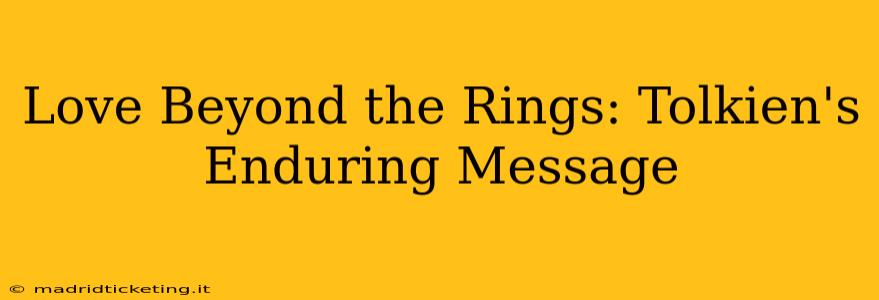J.R.R. Tolkien's The Lord of the Rings is more than just a thrilling adventure; it's a profound exploration of love in its myriad forms. While epic battles and fantastical creatures dominate the narrative, the enduring power of the story stems from the deeply interwoven threads of love that bind its characters and drive its plot. This essay delves into the diverse expressions of love found within Tolkien's masterpiece, examining how these relationships contribute to the overarching themes of hope, sacrifice, and the triumph of good over evil.
What are the different types of love portrayed in Lord of the Rings?
Tolkien masterfully portrays a spectrum of love, moving beyond the simplistic romantic ideal. We see familial love in the bonds between Frodo and Bilbo, Sam and his family, and the enduring loyalty within the Fellowship. There's the deep friendship between Aragorn, Legolas, and Gimli, showcasing camaraderie and unwavering commitment in the face of danger. Romantic love is present, but subtly woven into the tapestry of the narrative, most notably in the burgeoning relationship between Aragorn and Arwen. Finally, the overarching theme is perhaps best described as agape, the selfless, unconditional love exemplified by the sacrifice of many for the greater good of Middle-earth.
How does the love between Frodo and Sam represent the power of friendship?
The relationship between Frodo and Sam is arguably the most potent example of enduring friendship and loyalty in the entire saga. Sam's unwavering devotion to Frodo, even in the darkest moments of their journey, transcends mere companionship. It represents a selfless love, a commitment to a friend's well-being that surpasses all personal comfort and safety. Sam's steadfastness provides Frodo with the strength to continue when all hope seems lost, showcasing the transformative power of true friendship. Their bond serves as a beacon of hope, reminding us of the importance of loyalty and unwavering support in the face of overwhelming adversity.
Is there romantic love in The Lord of the Rings?
While not the central focus, romantic love is subtly yet powerfully present. The relationship between Aragorn and Arwen, though somewhat sidelined by the epic scope of the quest, is a poignant portrayal of enduring love across societal divides and even the chasm of mortality. Arwen’s choice to forsake immortality for Aragorn highlights the depth and sacrifice inherent in true love. Their love story acts as a counterpoint to the epic struggle, reminding us of the importance of personal connection and the enduring power of love even amidst chaos and despair. It shows that even in a world threatened by darkness, the flame of love can continue to burn brightly.
How does Tolkien's portrayal of love contribute to the overall themes of the story?
Tolkien's portrayal of love isn't simply a romantic subplot; it's integral to the story's core themes. The various forms of love—familial, platonic, romantic, and agape—intertwine to create a powerful tapestry of resilience and hope. Each act of love, from the smallest gesture of kindness to the ultimate sacrifice, contributes to the ultimate triumph of good over evil. The enduring power of these relationships demonstrates that even in a world consumed by darkness, love persists and ultimately prevails. It is this message of enduring hope and the power of love in its many forms that makes Tolkien's work so timeless and relevant.
What lessons about love can we learn from Tolkien's work?
The Lord of the Rings offers profound lessons about love's many facets. It shows us the unwavering strength of familial bonds, the transformative power of true friendship, and the enduring nature of romantic love. But most importantly, it highlights the significance of agape—the selfless, unconditional love that drives characters to make sacrifices for a greater good. This emphasis on selflessness and commitment teaches us the importance of compassion, empathy, and the profound impact of choosing love over self-preservation. The enduring legacy of Tolkien's work lies not just in its fantastical elements but in its powerful and timeless message about the transformative and enduring power of love in all its forms.

